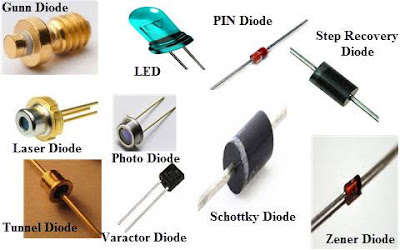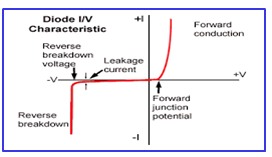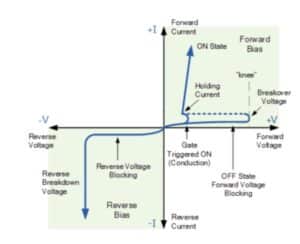Understanding why is diode non-ohmic semiconductor device requires a closer look at how it responds to applied voltage. Unlike resistive components that follow Ohm’s law with a constant ratio of voltage to current, a diode exhibits a nonlinear V-I characteristic.
A diode remains non-conductive up to a certain voltage threshold and then allows current to rise rapidly, indicating variable resistance.
This behavior stems from the internal structure of the PN junction, making the diode a classic example of a non-ohmic semiconductor device.
What Are Ohmic Conductors?
The conductors that obey the ohm’s law are called ohmic conductors. In an ohmic conductor, the current and the voltage have a linear relationship. The current increases or decreases as the voltage is increased or decreased. The non-ohmic conductor has a non-linear current-voltage relationship.
The resistance, inductance, and capacitor follow Ohm’s law—the current increases with an increase in the voltage.
Ohm’s Law:
R= V/I
I=V/R
Where,
V= Applied Voltage
I = Current in the circuit
R = Circuit Resistance
If the slope of the V-I graph is constant, the current and voltage have a linear relationship. The slope of the V-I graph can be constant only if the resistance of the circuit remains unchanged.
What Are Non-Ohmic Conductors?
The nonohmic conductor does not follow Ohm’s Law, and the current drawn by the nonohmic conductor does not proportionately vary with the varying applied voltage.
The resistance of a non-ohmic conductor does not remain constant when voltage is applied across it. The changing resistance results in a change in the current for a particular voltage, and the V-I graph is no longer linear.

If we take the slope of the V-I curve of the above graphs, the resistor has a constant slope because of the constant resistance. The filament has variable resistance because the slope of the V-I graph is not constant.
V-I Characteristics: Ohmic vs. Non-Ohmic Conductors (Comparison Table)
| Parameter | Ohmic Conductor | Non-Ohmic Conductor |
| Obeys Ohm’s Law? | Yes | No |
| V-I Relationship | Linear | Non-linear |
| Resistance Behavior | Constant | Variable |
| V-I Graph | Straight line | Curved/Exponential |
| Examples | Resistors, metallic wires | Diodes, SCR, IGBT, LED |
Why Is a Semiconductor Diode Non-Ohmic?
All the semiconductor devices are non-linear devices because the current drawn by the devices is not proportional to the applied voltage.
The semiconductor devices have a barrier potential, and when the applied voltage is increased above the barrier potential, the device starts conducting.
If the voltage is increased above the barrier potential, the voltage across the device remains constant, and the current starts increasing. This happens because the concentration of the holes and electrons increases as the current through the device is increased.
The resistance of the PN junction is not constant and does vary with the flow of electric current through the junction. The voltage and current have nonlinearity in the semiconductor junction diode.
Almost all the semiconductor devices which have nonlinear V-I relationships are depicted below.

The V-I graph of the semiconductor diode has an exponential relationship.

If we see the V-I curves of a semiconductor device, the current rises abruptly when the voltage reaches a particular value. The diode current equation is given below.

Where,
Io= Saturation Current
q= Charge of an electron- 1.6 *10–19 Coulomb
K=Boltzmann Constant- 1.38 * 10– 23 JK–1
T= Temperature(K)
The diode current increases exponentially when the voltage is increased above a particular value.
Examples of Non-Ohmic Semiconductor Devices
Similarly, the V-I characteristics of silicon control rectifier(SCR) are also non-linear.

The nonlinearity in the current with applied voltage causes harmonic distortion and other problems in the electrical network. Insulated Gate Bipolar Transistors (IGBTs) are widely used in variable frequency drives and uninterrupted power supply(UPS).
The IGBT has non-linear V-I characteristics.

The collector current does not vary proportionately with an increase in the collector-to-emitter voltage.
Conclusion: Why Are Diodes and Semiconductors Non-Ohmic?
A semiconductor diode is a non-ohmic device because it does not follow Ohm’s Law. Its current–voltage (V-I) relationship is nonlinear, meaning the current does not increase proportionally with the voltage.
This behavior is due to the barrier potential in the PN junction. Only after the applied voltage exceeds this threshold does the diode conduct, and even then, the current increases exponentially, not linearly.
As a result, resistance varies with voltage, which is the defining feature of a non-ohmic conductor.
Devices such as filament lamps, SCRs, and IGBTs also show similar nonlinear V-I characteristics. Understanding this helps explain why semiconductors are non-ohmic and why diode ohmic resistance isn’t constant.
FAQs
A semiconductor diode is non-ohmic because it does not follow Ohm’s law. It only conducts current after crossing the threshold voltage, and the current increases exponentially beyond this point.
Semiconductors are non-ohmic due to the presence of a junction barrier potential and variable resistance that depends on charge carrier concentration.
A non-ohmic device does not maintain a constant resistance and does not follow Ohm’s law. Examples include diodes, transistors, SCRs, and filament lamps.
A filament lamp becomes non-ohmic because its resistance increases with temperature, causing the V-I curve to become non-linear.
It’s a non-linear curve, showing that current does not increase in direct proportion to voltage.
Related Articles: